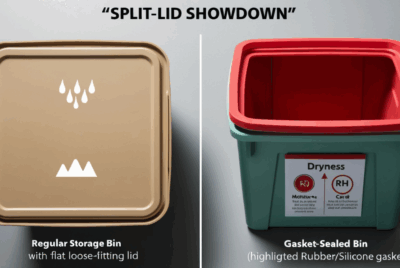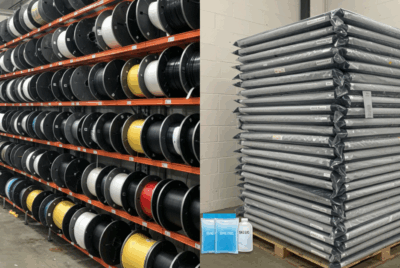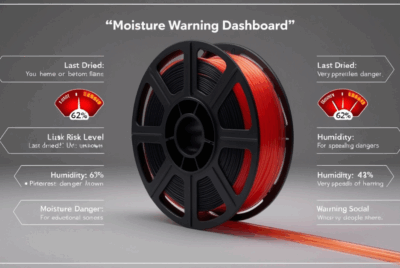Can Filament Really Go “Bad” Over Time If Stored Improperly?
1. Is Filament the New Expired Milk?
You probably don’t think of plastic as something that “expires,” right? But if you’ve left a spool sitting around in humid air or direct sunlight for too long… surprise! That filament may have gone a bit funky.
Let’s talk about whether 3D printer filament can go bad—and how to stop it from happening.
2. What Happens When Filament “Goes Bad”?
When filament goes bad, it’s not moldy or stinky like spoiled food—but the results are just as disappointing.
- Instead of crisp, clean layers, you get:
- Brittle, breaking filament
- Uneven extrusion
- Warped or stringy prints
- Nozzle clogs and failed jobs
Basically: stress, mess, and wasted time.
3. The Science of Filament Breakdown
Here’s the deal: most filaments are hygroscopic, which means they absorb moisture from the air. Over time, moisture degrades the polymer structure.
- Also, exposure to:
- UV light
- Heat
- Fluctuating humidity
…can further break down the material, making it fragile and unusable.
4. 3 Signs Your Filament is Past Its Prime
Wondering if that dusty spool on your shelf still has life in it? Here’s what to look for:
- It snaps easily when bent
- It makes popping or sizzling sounds while printing
- It causes poor adhesion or inconsistent layers
5. Environmental Factors That Speed Up Degradation
Your environment plays a huge role. Filament goes bad faster when exposed to:
| Condition | Risk Level |
|---|---|
| High humidity (>50% RH) | 🔥 High |
| Direct sunlight | ⚠️ Medium |
| Extreme heat or cold | ⚠️ Medium |
| Poor air circulation | ⚠️ Medium |
6. How Long Does Filament Last in Storage?
General Shelf-Life Estimates (Unopened & Properly Stored):
| Filament Type | Lifespan Estimate |
|---|---|
| PLA | 2+ years |
| ABS | 1.5–2 years |
| PETG | 1.5–2 years |
| Nylon | < 1 year |
| TPU | ~1.5 years |
💡 Tip: These lifespans shrink dramatically without proper storage.
7. Can You Still Use Old Filament?
Sometimes, yes.
- If the filament’s not brittle and hasn’t absorbed too much moisture, a quick drying session in a filament dryer or oven might bring it back to life.
But don’t expect perfect prints. Old filament usually behaves a little… unpredictable.
8. When to Toss a Spool (and When to Save It)
- Toss it if:
- It shatters easily while unspooling
- It no longer feeds smoothly into your printer
- The outer surface looks chalky or bubbly
- Save it if:
- It just seems “off” but hasn’t broken yet
- You have a filament dryer to try reviving it
- You’re prototyping something that doesn’t need high quality
9. Which Filaments Degrade the Fastest?
Here’s the order from most fragile to most forgiving:
| Most Sensitive | More Forgiving |
|---|---|
| Nylon | PLA |
| TPU | PETG |
| PVA | ABS |
Nylon and PVA absorb moisture incredibly fast and degrade quickly if left out.
10. Does Expired Filament Affect Print Quality?
Yes—sometimes dramatically.
- Symptoms of “expired” filament include:
- Stringing, even with tuned retraction
- Brittle prints that crumble easily
- Unreliable adhesion between layers
- Under-extrusion and weak spots
11. Can You “Restore” Bad Filament?
If it’s just moisture damage? Yes.
- Drying filament in a tool like:
- SUNLU S2 Dryer Box
- PrintDry Pro
- Oven at 50°C (low and slow)
…can bring it back to usable condition. But if it’s chemically degraded from UV or heat, it’s game over.
12. Best Storage Habits to Extend Filament Life
To make your filament last as long as possible:
- Store it in airtight containers with silica gel
- Use vacuum-sealed bags when not in use
- Keep away from sunlight and moisture
- Monitor with a hygrometer to ensure <40% RH
13. Vacuum Sealing vs. Dry Boxes: Which Wins?
| Storage Method | Best For | Pros | Cons |
|---|---|---|---|
| Vacuum Sealing | Long-term, infrequent use | Inexpensive, compact | Slower access |
| Dry Boxes | Active printing or daily use | Instant access, monitors RH | Slightly more expensive |
The ideal setup? Both. Use dry boxes for your go-to spools, and vacuum seal your backups.
14. Should You Ever Buy Used or Clearance Filament?
Only if:
- The spool is sealed and stored properly
- It comes from a reputable source
- You’re willing to test and possibly dry it first
Avoid sketchy deals unless you like surprises.
15. Final Thoughts: Think of Filament Like Fine Wine
Filament doesn’t exactly get better with age—but how you store it makes all the difference. Like a fine wine, treat it right, and it’ll reward you with top-notch performance.
But ignore it, and you might as well be printing with uncooked spaghetti.
❓FAQs
- Can filament actually expire?
Not in the food sense, but it can degrade and become unusable if exposed to moisture or light for long periods. - What does “bad” filament look like?
It’s often brittle, uneven in color, or has visible bubbling or cracking. - Is it dangerous to use old filament?
No, but it can clog your nozzle or ruin your prints. - Can I mix old filament with new in a print?
Technically yes, but it may result in inconsistent extrusion or layer bonding. - Does dry filament ever “go bad” without moisture?
Yes—heat, UV light, or chemical aging can degrade filament even if it’s dry.




